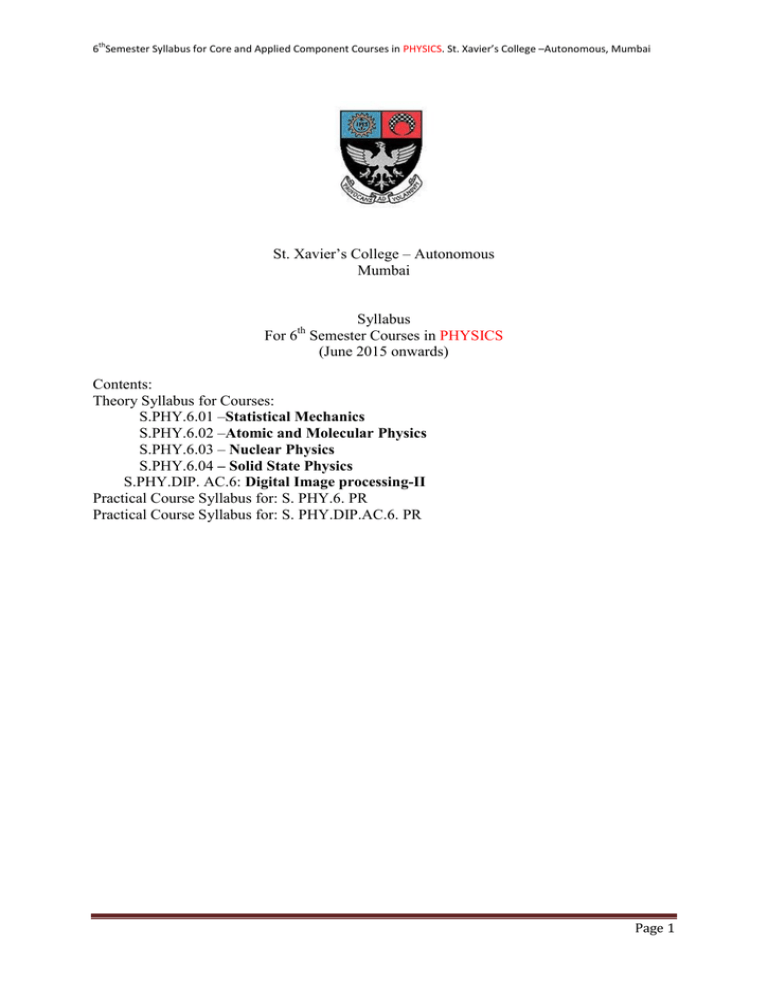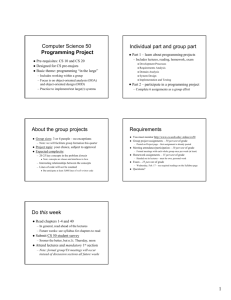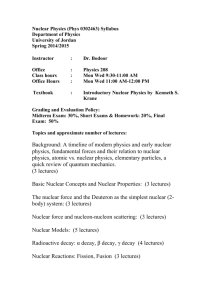6 Semester Syllabus for Core and Applied Component Courses in PHYSICS
advertisement

th 6 Semester Syllabus for Core and Applied Component Courses in PHYSICS. St. Xavier’s College –Autonomous, Mumbai St. Xavier’s College – Autonomous Mumbai Syllabus For 6 Semester Courses in PHYSICS (June 2015 onwards) th Contents: Theory Syllabus for Courses: S.PHY.6.01 –Statistical Mechanics S.PHY.6.02 –Atomic and Molecular Physics S.PHY.6.03 – Nuclear Physics S.PHY.6.04 – Solid State Physics S.PHY.DIP. AC.6: Digital Image processing-II Practical Course Syllabus for: S. PHY.6. PR Practical Course Syllabus for: S. PHY.DIP.AC.6. PR Page 1 th 6 Semester Syllabus for Core and Applied Component Courses in PHYSICS. St. Xavier’s College –Autonomous, Mumbai T.Y. B.Sc. PHYSICS Course: S.PHY.6.01 Title: Statistical Mechanics Learning Objectives: To study statistical behaviour of many particle systems. Number of lectures: 60 UNIT I (15 Lectures) 1. Probability: Set theory, introduction to probability, conditional probability, Random walk problem, discrete Random variables, combining probabilities of events, probability distribution moments, the moment generating function, the characteristic function, binomial distribution, the central limit theorem. 2. Introduction to Statistical Mechanics: description of a system, thermal and adiabatic interaction, classical gas. UNIT II (15 Lectures) 1. Kinetic theory: phase space formulation, the Boltzmann transport equation, the postulate of molecular chaos, the H theorem, the Maxwell-Boltzmann distribution (emphasize the connection with the proof of the central limit theorem), the most probable distribution, Liouville's theorem and its connection to the H theorem. UNIT III (15 Lectures) 1. The methods of statistical mechanics: the postulate of equal a priori probability in phase space, the microcanonical ensemble, entropy, the equipartition theorem, classical ideal gas, Gibbs paradox. The canonical ensemble, the partition function, the Helmholtz free energy, energy fluctuations in the canonical ensemble. UNIT IV (15 Lectures) 1. The grand canonical ensemble, density fluctuations in the grand canonical ensemble, first order phase transitions, the meaning of the Maxwell construction. 2. Quantum Statistics of ideal geases: Bose – Einstein statistics, black-body radiation, The Rayleigh-Jeans formula, The Planck radiation formula, Fermi – Dirac statistics, comparison of results, Transition between states. References: 1. 2. 3. 4. 5. Statistical and thermal physics – S. Loknathan, R. S. Gambhir Statistical Mechanics - Kerson Huang (Indian edition exists) Statistical Mechanics (Berkeley Physics Course, vol 5) - E. Reif Statistical and thermal physics - F. Reif Mathematical Methods of Physics - J. Mathews and R. L. Walker CIA: Problem solving/ MCQs __________________________________________________ Page 2 th 6 Semester Syllabus for Core and Applied Component Courses in PHYSICS. St. Xavier’s College –Autonomous, Mumbai T.Y.B.Sc. PHYSICS COURSE:S.PHY.6.02 Title: Atomic& Molecular Physics Learning Objectives: To study atomic structure and atomic and molecular spectra. No. of Lectures:60 UNIT I : Structure of atom (15 lectures) 1. Review of Hydrogen atom problem, Role of rotation symmetry 2. Pauli’s Exclusion Principle, Hund’s Rule, Symmetric &Antisymmetric Wave Function 1. Vector Atom Model , Spin Orbit Coupling, LS Coupling, JJ Coupling. Unit II: Atomic spectra (15 lectures) 1. Review concepts of quantum mechanics , Origins of Spectral Lines & Selection Rules. 2. Visible spectra, Alkali Spectra, Physics of LASERs (3level system). 3. X-ray spectra: Characteristic, Continuous, Mosley’s Law, K, L, M Series. 4. Atoms in External magnetic field: Normal Zeeman Effect, Lande’s Factor, Anomalous Zeeman Effect, 5. Paschen Back Effect:-Theory, selection rules, application to Principal Series Doublet. UNIT III: Molecular Spectra (Diatomic Molecule) (15 lectures) 1. Rotational Spectra, Microwave Spectrometer. 2. Vibrational Spectra, Vibrational - Rotational Spectra, Infrared Spectrometer. 3. Electronic Spectra, Born Oppenheimer Approximation, Intensity of Vibration Electronic Spectra, Frank – Condon Principle. 4. Raman Effect: Classical Theory, Quantum Theory, Pure Rotational Raman Spectra, Vibrational Raman, Raman Activity of CO2 and H2O, Experimental Techniques. UNIT IV: Resonance Spectroscopy (15 lectures) 1. Electron spin resonance, theory, experimental method, applications 2. Nuclear magnetic resonance, theory, experimental method, applications 3. Solid state surface spectroscopy. References: 1.Perspective of Modern Physics – A.Bieser. 2. Atomic Spectra - White. 3. Molecular spectra - C. M. Banwell & McCash. CIA: PROBLEM SOLVING/MULTIPLE CHOICE QUESTIONS/ ASSIGNMENT Page 3 th 6 Semester Syllabus for Core and Applied Component Courses in PHYSICS. St. Xavier’s College –Autonomous, Mumbai T.Y.B.Sc. PHYSICS Title:NUCLEAR PHYSICS No of Lectures:60 COURSE:S.PHY. 6.03 Learning Objectives:-To Understand the constituents of the nucleus, their properties, detection and reactions. UNIT-I: (15 LECTURES) 1.Properties of the nucleus: Rutherford scattering & measurement of nuclear size, Measurement of nuclearradius by Hofstadter experiment, Nuclear forces and their properties, Meson theory of nuclear forces, Yukawa Potential. 2. The Q equation:- Types of nuclear reactions, the balance of mass and energy in nuclear reaction , the Q equation and solution of Q equation 3. Radioactive decay: Decay chains.Alpha decay : Range of alpha particles, Disintegration energy, Alpha decay paradox: Barrier Penetration, Gamow’s theory of alpha decay and Geiger-Nuttal law. Velocity and energy, Absorption of alpha particles: Range, Ionization and stopping power, energetics, energy levels & decay schemes. Beta decay: Introduction, Continuous beta ray spectrum-Difficulties encountered to understand it, Pauli’s neutrino hypothesis, Velocity and energy of beta particles, energetics, energy levels and decay schemes. Gamma decay: internal conversion, nuclear isomerism. UNIT-II (15 LECTURES) 1.Binding Energy and Mass formula: (Review of Liquid drop model &Weizsacher’s semiempirical mass formula), Mass parabolas - Prediction of stability against beta decay for members of an isobaric family, Stability limits against spontaneous fission. Qualitative predictions of shell model & Magic numbers. 2. Nuclear energy : Introduction, Asymmetric fission - Mass yield, Emission of delayed neutrons, energy release in fission, Nature of fission fragments, Energy released in the fission of U235, Fission chain reaction, Fusion of lighter nuclei, Neutron cycle in a thermal nuclear reactor (Four Factor Formula), Comparison of fission and fusion processes. UNIT-III (15 LECTURES) 1. Applications of nuclear energy :- nuclear reactors:- pressurized water reactors, boiling water reactors, breeder reactors, fusion reactors.Nuclear detectors:- Ionization chamber, Proportional counter, G.M. Counter, Scintillation counter, Solid State detectors , Cloud and Bubble chamber, Mossbauer effect, Detection of neutrino, nuclear power generation, nuclear safety and hazards. UNIT-IV (15 LECTURES) 1.Accelerators:-Introduction, the LINAC, cyclotron, synchrocyclotron, betatron synchrotron, proton synchrotron, Electrostatic Accelerators. Page 4 th 6 Semester Syllabus for Core and Applied Component Courses in PHYSICS. St. Xavier’s College –Autonomous, Mumbai 2. Elementary particles : Introduction, Classification of elementary particles based on conservation laws, particles and antiparticles, The Fundamental interactions, elementary particle quantum numbers, conservation laws and symmetry, quark model,. References: 1. Concepts of modern physics 2. Nuclear Physics 3. Nuclear Physics 4. Nuclear Physics 5.Nuclear Physics 6. Modern Physics 7. Nuclear physics Additional References. 1. Atomic & Nuclear Physics 2.Nuclei and particles Arthur Beiser (6th edition, TMH) S.B. Patel (Wiley Eastern Ltd.). Irving Kaplan (2nd Ed.) (Addison Wesley). S. N. Ghoshal (S. Chand & Co.) D. C. Tayal (Himalayan Publishing House) Murugesan&KiruthigaSivaprasath ( S. Chand & Co.) Kakani & Kakani A B Gupta &DipakGhosh( Books & Allied (P) Ltd.) E.Segre. (W.A. Benjamin, Inc.) CIA: PROBLEM SOLVING/MULTIPLE CHOICE QUESTIONS/ ASSIGNMENTS T.Y.B.Sc. PHYSICS COURSE:S.PHY.6.04 Title:Solid State Physics No of Lectures:60 Learning objective: To understand the fundamental properties of materials and devices UNIT I : (15 lectures) Crystal physics: Introduction, lattice, basis, crystal structure, unit cell & primitive cell, crystal classes & crystal systems in two & three dimensions, Bravais lattices, atomic packing factors in cubic system and hexagonal lattice. Crystal structures of diamond, ZnS, Nacl, CsCl, Miller indices, Inter-planar spacing. Experimental diffraction methods, derivation of scattered wave amplitude, Brillouin zones , - Kittle 5thed UNIT - II (15 lectures) Theory of metals : Classical free electron theory of metals, Relaxation time, Collision time and mean free path, Drawbacks of classical theory, Quantum theory of free electrons, FermiDirac statistics and electronic distribution in solids, Density of energy states and Fermi energy, The Fermi distribution function, Heat capacity of the electron gas, Mean energy of electron gas at 0 K, Electrical conductivity from quantum mechanical considerations, Hall effect. Ch.6 – Kittle 5thed UNIT - III (15 lectures) 1. Band theory of solids: The Kronig- Penney model Brillouin zones, Number of wave functions in a band, Motion of electrons in a one-dimensional periodic potential, Distinction between metals, insulators and intrinsic semiconductors. Page 5 th 6 Semester Syllabus for Core and Applied Component Courses in PHYSICS. St. Xavier’s College –Autonomous, Mumbai 2. Band theory of Semiconductors: Electrons and Holes in an Intrinsic Semiconductor, Conductivity, Carrier concentrations, Donor and Acceptor impurities, Charge densities in a Semiconductor, Fermi level in extrinsic semiconductors, Diffusion, Carrier lifetime, The continuity equation. Ch. 7, 8 – Kittle 5thed UNIT - IV (15 lectures) 1. Magnetic properties of Matter: Diamagnetism and Paramagnetism, The origin of permanent magnetic dipoles, Diamagnetism and Larmor precession, The static paramagnetic susceptibility. Quantum mechanical theory of paramagnetism, Ferromagnetism- the Weiss molecular field, Comparison of the Weiss theory with experiment, the Weiss field, the anisotropy energy, the Bloch wall, coercive force and hysteresis. Ch. 18, 19 – Dekker 2. Superconductivity : concept, achievement at low temp, attempts at room temp. Examples. References : (i) Introduction to solid state physics - Charles Kittel (ii) Solid State Physics - A. J. Dekker (iii) Solid State Physics ( Problems and solutions) - S. O. Pillai (iv) Solid State Physics - S. O. Pillai (v) Solid State Physics - S.P.Kakani and AmitKakani CIA:PROBLEM SOLVING/MULTIPLE CHOICE QUESTIONS T.Y.B.Sc. PHYSICS Course: S.PHY.6.PR Minimum four expts to be performed from first three groups Group – I 1) 2) 3) 4) 5) Double Refraction. Log Decrement. Velocity of Ultrasonic waves in a liquid. Rydberg’s Constant – H2 Spectrum. Wavelength of spectral lines of Hg using Grating. Group – II 1) 2) 3) 4) 5) Energy band gap of semiconductor using diode / thermistor. Semiconductor diode as a temp. sensor. Determination of Planck’s constant with the help of a photoelectric cell. Absolute Capacitance using B.G Conversion of micrometer to a multirange milliammeter and voltmeter (Ohmmeter only Calculations.) Group – III 1) JFET Amplifier. 2) Wien’s Bridge Oscillator using OpAmp. Page 6 th 6 Semester Syllabus for Core and Applied Component Courses in PHYSICS. St. Xavier’s College –Autonomous, Mumbai 3) 4) 5) 6) Log Amplifier – using OpAmp. Active Integrator & Differentiator (learning skill of soldering). Monostable multivibrator& Ramp generator using 555 timer. First Order – Active filter (Low Pass / High Pass) with phase shift measurement (with skill of use of Breadboard). Group – IV One Project equivalent to 10 practical turns under the guidance of a teacher. References: 1. Advanced course in practical physics – D. Chattopadhyay, P.C. Rakshit& B. Saha 2. B. Sc. Practical physics – Harnam Singh 3. A text book of practical physics – Samir Kumar Ghosh 4. B. Sc. Practical physics – C. L. Arora 5. Practical physics – C. L. Squires 6. University Practical physics – D. C. Tayal 7. Advanced Practical physics – Worsnop& Flint CIA: MCQs on Conceptual understanding/ experimental skills for first three groups Planning, designing and preparation of synopsis of the project ___________________________________________________________________________ COURSE:S.PHY.DIP.AC.6 DIGITAL IMAGE PROCESSING -II [60 LECTURES] Learning objective: To study the mathematical modelling of digital images UNIT I (15 LECTURES) Color image processing Color Fundamentals Color Models Pseudocolor Image Processing Basics of Full-Color Image Processing Color Transformations Smoothing and Sharpening Image Segmentation Based on Color Noise in Color Images Color Image Compression Problems Wavelets and multi-resolution processing Background Multi-resolution Expansions Page 7 th 6 Semester Syllabus for Core and Applied Component Courses in PHYSICS. St. Xavier’s College –Autonomous, Mumbai Wavelet Transforms in One Dimension The Fast Wavelet Transform Wavelet Transforms in Two Dimensions Wavelet Packets Problems UNIT II Image compression Fundamentals Some Basic Compression Methods Digital Image Watermarking (15 LECTURES) UNIT III Morphological image processing Preliminaries Erosion and Dilation The Hit-or-Miss Transformation Basic Morphological Algorithms Gray-Scale Morphology (15 LECTURES) UNIT –IV Image segmentation Fundamentals Point, Line, and Edge Detection Thresholding Region-Based Segmentation Segmentation Using Morphological Watersheds The Use of Motion in Segmentation ( 15 LECTURES) Reference : 1. Digital image processing, third edition -Gonzalez and woods 2. . Digital image processing, third edition -A. K. Jain 3. . Digital image processing using MATLAB -Gonzalez and woods ___________________________________________________________________________ Practicals T.Y.BSc Digital Image processing-II COURSE: S.PHY.DIP.AC.6.PR Digital processing of given images using software Tutorials on image processing Page 8






![EEE 463 Electrical Power Plant (3) [F]](http://s3.studylib.net/store/data/008820995_1-274b98992bf2ca9a77f87b4e21ecfd81-300x300.png)
